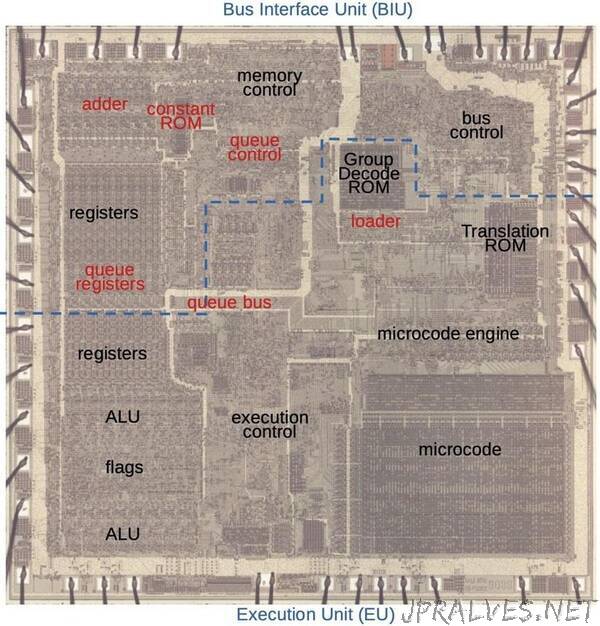
“The groundbreaking 8086 microprocessor was introduced by Intel in 1978 and led to the x86 architecture that still dominates desktop and server computing. One way that the 8086 increased performance was by prefetching: the processor fetches instructions from memory before they are needed, so the processor can execute them without waiting on the (relatively slow) memory. I’ve been reverse-engineering the 8086 from die photos and this blog post discusses what I’ve uncovered about the prefetch circuitry.
The 8086 was introduced at an interesting point in microprocessor history, where memory was becoming slower than the CPU. For the first microprocessors, the speed of the CPU and the speed of memory were comparable.1 However, as processors became faster, the speed of memory failed to keep up. The 8086 was probably the first microprocessor to prefetch instructions to improve performance. While modern microprocessors have megabytes of fast cache2 to act as a buffer between the CPU and much-slower main memory, the 8086 has just 6 bytes of prefetch queue. However, this was enough to increase performance by about 50%.3
The die photo below shows the 8086 microprocessor under a microscope. The metal layer on top of the chip is visible, with the silicon and polysilicon mostly hidden underneath. Around the edges of the die, bond wires connect pads to the chip’s 40 external pins. I’ve labeled the key functional blocks; ones that are important to the prefetch queue are highlighted in red and will be discussed in detail below. Architecturally, the chip is partitioned into a Bus Interface Unit (BIU) at the top and an Execution Unit (EU) below. The BIU handles memory accesses, while the Execution Unit (EU) executes instructions.
Prefetching and the architecture of the 8086
Prefetching had a major impact on the design of the 8086. Earlier processors such as the 6502, 8080, or Z80 were deterministic. The processor fetched an instruction, executed the instruction, fetched the next instruction, and so forth. Memory accesses corresponded directly to instruction fetching and execution and instructions took a predictable number of clock cycles. This all changed with the introduction of the prefetch queue. Memory operations became unlinked from instruction execution since prefetches happen as needed and when the memory bus is available.
Since memory operations and instruction execution happen independently, the implementors of the 8086 split the chip into two processing units: the Bus Interface Unit (BIU) that handles memory accesses, and the Execution Unit (EU) that executes instructions, as shown below.4 The Bus Interface Unit contains the 6-byte instruction prefetch queue; it supplies instructions to the Execution Unit via the Q (queue) bus. The adder (Σ) performs address calculation, adding the segment register base to an address offset, among other things. The Execution Unit is what comes to mind when you think of a processor: it has most of the registers, the arithmetic/logic unit (ALU), and the microcode that implements instructions. The address adder and the ALU are independent arithmetic units. The segment registers (CS, DS, SS, ES) and the Instruction Pointer (IP) are in the Bus Interface Unit since they are directly involved in memory accesses, while the general-purpose registers are in the Execution Unit.”
